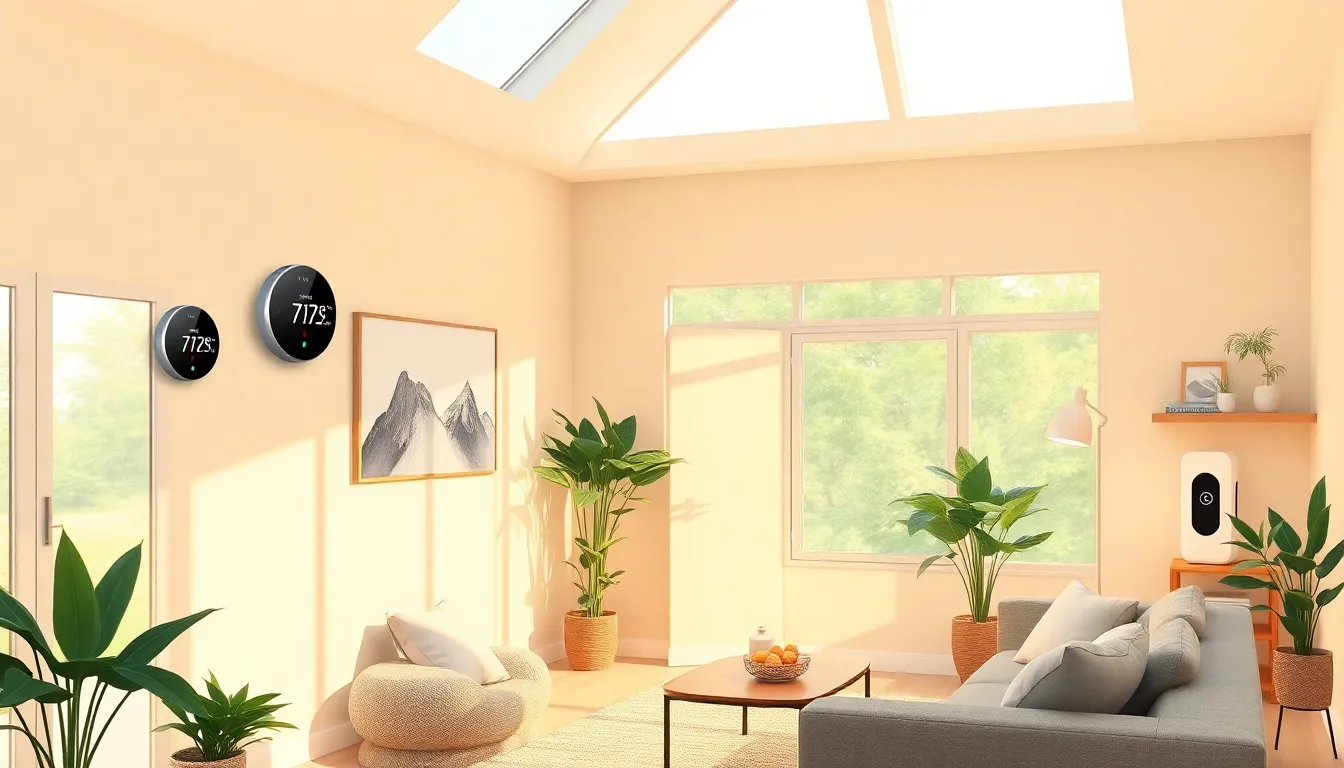In a world where the thermostat wars rage on and dust bunnies seem to have formed their own nation under the couch, home environment control is the unsung hero of modern living. Imagine a space where the air is fresh, the temperature is just right, and the only thing that sneezes is your cat. With the right tools and a sprinkle of tech-savvy, anyone can transform their home into a sanctuary of comfort and style.
From smart thermostats that know your favorite cozy settings to air purifiers that can make your home feel like a mountain retreat, controlling your environment isn’t just a luxury—it’s a necessity. So why settle for a home that feels like a sauna one minute and an icebox the next? Let’s dive into the world of home environment control and discover how to turn your living space into the ultimate comfort zone.
Table of Contents
ToggleOverview of Home Environment Control
Home environment control significantly impacts comfort and well-being. Effective management encompasses temperature, air quality, and lighting. Smart thermostats allow homeowners to adjust heating and cooling remotely, optimizing energy efficiency. Air purifiers remove allergens and pollutants, enhancing indoor air quality.
Automation systems provide seamless integration of various components. With these systems, users can schedule operations based on preferences. Smart lighting adjusts brightness according to natural light, improving mood and energy levels. Sensors detect occupancy and adapt settings accordingly, ensuring comfort while conserving energy.
Humidity controls maintain optimal levels, preventing mold growth and preserving furnishings. Optimal humidity levels range from 30% to 50%. Monitoring devices alert homeowners when adjustments are necessary, promoting a healthier living space.
Data-driven insights guide informed decisions about home environment control. Smart devices track patterns and provide recommendations for improvements. This adaptability contributes to a more personalized experience, appealing to individual preferences and needs.
Integrating these technologies fosters a harmonious environment. Homeowners experience reduced energy costs and increased property value through efficient systems. Investing in home environment control not only enhances comfort but also supports sustainability efforts.
Prioritizing effective management of these elements leads to a more enjoyable living space. Improved home environment control contributes to overall quality of life. Homeowners who embrace these innovations often find greater satisfaction in their daily routines.
Importance of Home Environment Control

Home environment control plays a crucial role in enhancing comfort and well-being. Proper management leads to a significant improvement in the home atmosphere.
Health Benefits
Maintaining air quality contributes to better respiratory health. Smart air purifiers effectively remove allergens and pollutants, reducing allergy symptoms. Regularly controlling humidity prevents mold growth, protecting both health and property. It creates a safe environment for children and pets by minimizing exposure to harmful contaminants. Well-regulated temperature promotes restful sleep, improving overall energy levels during the day. Implementing these measures fosters a healthier lifestyle and ensures a comfortable living space.
Energy Efficiency
Optimizing home environment control significantly boosts energy efficiency. Smart thermostats automatically adjust heating and cooling, leading to reduced energy consumption. Scheduling operations based on daily routines minimizes waste, cutting down energy bills. Energy-efficient lighting systems respond to natural light levels, ensuring efficient use of electricity. Sensors further enhance efficiency, adjusting settings according to occupancy. Integrating these technologies not only conserves energy but also increases property value. Homeowners experience economic benefits and contribute to sustainability through responsible energy management.
Key Components of Home Environment Control
Effective home environment control relies on several key components that enhance comfort and well-being. Understanding these elements helps create a more harmonious living space.
Smart Thermostats
Smart thermostats enable precise temperature management for homes. They allow homeowners to adjust heating and cooling settings remotely, improving energy efficiency by learning user preferences. Scheduling features also optimize energy use during peak and off-peak hours. Data analytics from these devices provide insights, helping users to fine-tune their settings. Integrating with home automation systems enhances overall climate control, making it easier to maintain consistent comfort levels.
Air Quality Monitors
Air quality monitors play a crucial role in maintaining a healthy indoor environment. These devices detect pollutants, allergens and humidity levels in real time. Alerts notify homeowners when air quality deteriorates, prompting timely action. With advancements in technology, some monitors can connect to air purifiers to enhance indoor air quality further. Regular usage of air quality monitors helps reduce respiratory issues and allergy symptoms, ensuring a safer space for all inhabitants.
Lighting Control Systems
Lighting control systems contribute significantly to a comfortable atmosphere in the home. These systems allow for adjustment of brightness and color temperature based on natural light conditions and personal preference. Occupancy sensors can automatically turn lights on or off, improving energy efficiency. Smart bulbs work in tandem with control systems, providing customizable lighting scenarios for various activities. Implementing effective lighting solutions enhances mood and productivity while conserving energy, creating a pleasant living environment.
Implementing Home Environment Control Systems
Integrating home environment control systems enhances comfort and promotes well-being. Selecting optimal technologies and ensuring proper installation contribute to improved living spaces.
Choosing the Right Technology
Smart thermostats offer precise temperature management and energy efficiency. Air quality monitors detect pollutants, allowing for timely intervention. Lighting control systems adjust brightness and color temperature, optimizing mood and productivity. Homeowners can prioritize devices that feature user-friendly interfaces and compatibility with existing systems. Many options also provide remote access, enabling control from smartphones and tablets. Opting for integrated systems ensures seamless operation and promotes energy savings. A focus on energy-efficient devices supports sustainability while enhancing property value.
Installation and Setup Considerations
Professional installation often guarantees optimal performance of control systems. Assessing existing home infrastructure is crucial to determine compatibility with new technologies. Homeowners should consider wiring requirements, network connectivity, and space for equipment. Proper placement of sensors and monitors affects their effectiveness. Testing systems after installation ensures all components function well with each other. Following manufacturer guidelines during setup helps prevent common issues. By prioritizing these considerations, homeowners can achieve a harmonious environment that aligns with their preferences and lifestyle.
Future Trends in Home Environment Control
Emerging technologies in home environment control focus on automation and integration. Smart home ecosystems increasingly utilize artificial intelligence to predict user needs. Enhanced machine learning algorithms improve the efficiency of devices, optimizing energy consumption while maintaining comfort.
Integration with other home technology platforms provides a seamless user experience. Voice-activated assistants simplify control over various systems, allowing users to manage settings with ease. Advanced scheduling features enable devices to automatically adjust based on routines, ensuring an ideal environment without manual input.
Sustainability plays a crucial role in future developments. Smart thermostats incorporate renewable energy data, enabling homeowners to make eco-friendly choices. Energy-efficient appliances can automatically sync with these systems, maximizing energy savings.
Data privacy and security considerations also shape future trends. Manufacturers prioritize robust security protocols to protect user information as home systems become more interconnected. Updates and patches for vulnerabilities will become essential to maintain system integrity.
Air quality management will see advancements with the introduction of IoT-connected sensors. These devices monitor air quality in real time, providing alerts and suggestions for improvement. Integration with smart HVAC systems enables automatic adjustments based on air quality readings.
In addition, advances in user interface design contribute to improved usability. Intuitive apps allow homeowners to customize settings easily, making technology accessible for all age groups. User-friendly interfaces ensure that individuals can monitor and control their environments without a steep learning curve.
Investing in these innovations enhances property value while improving quality of life. As technologies evolve, a more connected, efficient, and comfortable home environment will emerge, aligning with modern living demands. Homeowners benefit significantly by adapting to these trends today.
Home environment control is essential for enhancing comfort and well-being. By integrating smart technologies like thermostats and air purifiers homeowners can create a balanced atmosphere that promotes health and energy efficiency. The seamless automation of these systems not only simplifies daily routines but also contributes to significant cost savings.
Investing in these innovations leads to a more personalized living space that adapts to individual preferences. As technology continues to evolve the future of home environment control promises even greater convenience and sustainability. Embracing these advancements ensures a healthier home and a more enjoyable lifestyle for everyone.








